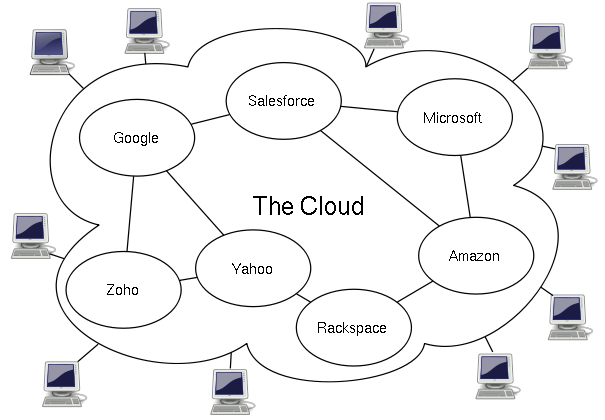If you haven't already caught on to using cloud computing, then you'd better move quickly because "mobile cloud computing" is the current flavor.
Like any cloud computing, it is when the infrastructure - the data storage and the data processing - happen outside of the (mobile) device.
If you are using applications like Gmail, Google Maps, and Google Documents, then you are using cloud computing whether you do it on your laptop, desktop or mobile device. In the mobile world, there are still many (a majority?) of applications that do most of the data storage and processing on the mobile devices itself and not in the cloud.
The term "cloud" is used as a metaphor for the Internet. In computer network diagrams, the Net is depicted in the shape of a cloud. Installing Microsoft Office on your computer and storing your documents, spreadsheets, databases and PowerPoints on your hard drive is NOT cloud computing.
What is so appealing about using the cloud? For one thing, as a user, you do not need knowledge of, expertise in, or control over the technology infrastructure about the cloud network you are using. If you use those Google applications, then Google is your IT department. They handle the updates, backups and emergencies. Users also like that they can move from computer to computer (home, office, on the road, another classroom location) and all their data is waiting for them - not on a flashdrive or disk (Does anyone use those any more?) - in the cloud.
That cloud might include infrastructure as a service (IaaS), the platform as a service (PaaS - ex: Salesforce, Amazon Web Services), or, most commonly for the average user, software as a service (SaaS).
More people are purchasing lightweight netbook computers and also keeping the software load on the computer light by using software in the cloud.
I store all my personal bookmarks in the cloud using
Xmarks which works with Firefox, Safari and Internet Explorer. The service automatically syncs up any changes I make to my bookmarks so that what I have on my home computer is also available on my work computer. A few years ago, I would have copied the bookmarks file and then "tried" to copy them over to another computer. Very difficult to "synchronize." When I bought a new laptop recently, I just added the Xmarks plug-in and clicked sync and all my bookmarks were there.
Tech pundits (see link at bottom) are saying that cloud computing will become a disruptive force in the mobile world.
Why? First, the sheer number of users it can reach. Second, mobile applications are currently tied to a carrier. Want an iPhone or Blackberry app? You need a relationship with the mobile operator who carries the iPhone or Blackberry. But with mobile cloud applications, all you need is access to the web to use the application. (see
Google Android?)
The first mobile cloud apps will probably be business-focused, but big education players (like Blackboard) are already showing their mobile apps for collaboration, data sharing, multitasking, scheduling and even navigation and mapping for your campus.
So, the cloud is the place to be, right? Well, there are some problems or poetential problems. Not everyone has a smart featurephone. Not everyone or everywhere has really fast mobile Internet access. The U.S. is behind in its 3G coverage outside urban areas. And what happens to all your data (like your presentation, class notes and your thesis) when you can't get online? Do you trust Google to protect your data?
Maybe new technologies, like
HTML5 which does local caching, will help. Some pundits predict we may end up accessing the web on mobile devices with something other than a "browser."
Friends of mine know that I am not a big mobile user and definitely not a smartphone user. But I keep up with the trends, particularly in education. I was talking last week with some educators at a conference at UCONN and pointed out that many of the better practices I encounter come from business, not education. Take this case study on "
Making the Transition to a Virtual Classroom in the Cloud" by Christine Mikolajczak. It's not from a school, but from
ASTD -
the American
Society for Training & Development, the "world’s largest
association dedicated to workplace learning and performance
professionals."
I wonder how her four goals would fit those of your classroom - or the goals of your administration...
1. offer a remote training option for learners who could not travel on-site
2. create a new delivery option for end users
3. reduce operating and maintenance costs on a per class basis
4. launch the new program within 30 days.
I am not saying that we should necessarily be looking at the same stand-alone virtualization platforms and distance learning tools, (They used
Skytap’s Virtual Lab in the cloud in this case) but we should be looking at what they are doing and how they are doing it.
I learned when I was the manager of instructional technology at NJIT and we created distance learning products for non-educational clients, that accountability, return on investment and adherence to standards (like
SCORM) were taken far more seriously outside academia. In her case study, they accomplished "all of our objectives with a limited budget" launched a new training program "in record time" had "learners [are] excited about using the new solution," and they were "able to lower our tuition rates by 66 percent."
Wow. Call the provost.
See:
http://www.readwriteweb.com/archives/why_cloud_computing_is_the_future_of_mobile.php

